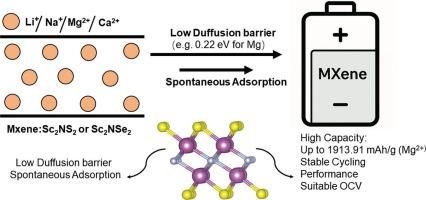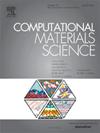探索二维Sc2NX2 MXene作为金属离子(Li+, Na+, Mg2+和Ca2+)电池负极材料的潜力:一项DFT研究
IF 3.3
3区 材料科学
Q2 MATERIALS SCIENCE, MULTIDISCIPLINARY
引用次数: 0
摘要
二维MXene材料以其优异的导电性和能量密度而闻名,作为金属离子电池的电极具有巨大的潜力。采用密度泛函理论计算了Sc2NX2 (X = F, Cl, S, Se, P, Si) MXenes作为阳极材料的电势。稳定性分析表明,Sc2NF2、Sc2NCl2、Sc2NS2和Sc2NSe2具有良好的动力学、力学和热稳定性,可以通过实验合成。相反,Sc2NP2和Sc2NSi2不稳定,不适合电极应用。对Li、Na、Mg和Ca离子在衬底表面的吸附研究表明,这些金属离子在Sc2NS2和Sc2NSe2表面自发且稳定地吸附,而这些离子在Sc2NF2和Sc2NCl2表面的吸附较差,限制了它们作为电极材料的使用。进一步评价了Sc2NS2和Sc2NSe2的电子特性、迁移行为、理论容量和OCV。Sc2NS2对Na、Mg和Ca的容量分别为956.96、1913.91和637.98 mAh/g,而Sc2NSe2的容量分别为614.09、818.79和409.39 mAh/g。这两种材料都具有较小的扩散阻力和最佳的OCV值。综上所述,Sc2NS2和Sc2NSe2因其卓越的稳定性、大容量和高效的离子迁移特性而成为Na、Mg和Ca金属离子电池极有前景的负极材料。本文章由计算机程序翻译,如有差异,请以英文原文为准。

Exploring the potential of 2D Sc2NX2 MXene as an anode material for metal-ion (Li+, Na+, Mg2+, and Ca2+) batteries: A DFT study
2D MXene materials, renowned for their superior electrical conductivity and energy density, hold great potential as the electrodes for metal − ion batteries. Density functional theory calculations were employed for the potential of Sc2NX2 (X = F, Cl, S, Se, P, Si) MXenes as anode materials. Stability analysis reveals that Sc2NF2, Sc2NCl2, Sc2NS2, and Sc2NSe2 exhibit excellent dynamic, mechanical, and thermal stability, and are likely to be experimentally synthesizable. Conversely, Sc2NP2 and Sc2NSi2 are unstable and unsuitable for electrode applications. Adsorption studies of Li, Na, Mg, and Ca ions on the substrate surface show that these metal ions spontaneously and stably adsorb on the surfaces of Sc2NS2 and Sc2NSe2, whereas the poor adsorption of the ions on Sc2NF2 and Sc2NCl2 limits their use as electrode materials. Further evaluation was carried out on the electronic characteristics, migration behaviors, theoretical capacities, and OCV for Sc2NS2 and Sc2NSe2. Sc2NS2 achieves notable capacities of 956.96, 1913.91, and 637.98 mAh/g for Na, Mg, and Ca, while Sc2NSe2 displays capacities of 614.09, 818.79, and 409.39 mAh/g. Both materials feature small diffusion resistance and optimal OCV values. In conclusion, Sc2NS2 and Sc2NSe2 emerge as highly promising anode materials for Na, Mg, and Ca metal-ion batteries because of the remarkable stability, large capacities, and efficient ion migration properties.
求助全文
通过发布文献求助,成功后即可免费获取论文全文。
去求助
来源期刊

Computational Materials Science
工程技术-材料科学:综合
CiteScore
6.50
自引率
6.10%
发文量
665
审稿时长
26 days
期刊介绍:
The goal of Computational Materials Science is to report on results that provide new or unique insights into, or significantly expand our understanding of, the properties of materials or phenomena associated with their design, synthesis, processing, characterization, and utilization. To be relevant to the journal, the results should be applied or applicable to specific material systems that are discussed within the submission.
 求助内容:
求助内容: 应助结果提醒方式:
应助结果提醒方式:


